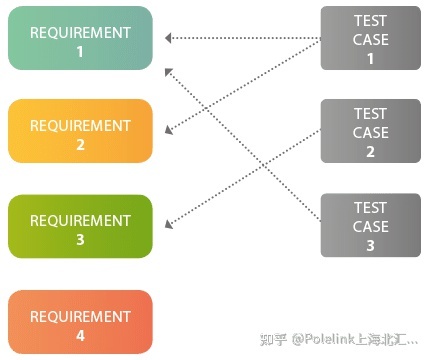Model-based testing tool TPT – Requirements Management
TPT’s Demand Tracking
TPT helps you track requirements in your tests. industry standards such as IEC 61508, DO-178C, EN 50128 or ISO 26262 require requirements tracking.
To ensure that at least one test case exists for each requirement, you can link the requirements in TPT to test cases. Typically, a single requirement can be linked and tested with several test cases. A single test case can also be linked to several requirements at the same time.
Using TPT, you can import complete requirements from IBM Rational DOORS, Polarion, ReqIF, codebeamer, or Excel and link them to test cases in TPT. In the event of a requirement change, TPT highlights the test cases linked to the changed requirement so you can easily see which test cases should be checked for conformance to the changed requirement.TPT helps you keep the test cases in sync with the current version of the requirement. This way, you can ensure that requirements coverage is consistent.

Figure 1. Linking test cases to requirements in TPT
Requirement Coverage
Unlike code coverage, which tests whether code is executed, requirements coverage tests whether code does what it is supposed to do. Using TPT, you can adequately perform requirements-based testing.
In particular, TPT links tests to requirements and shows missing tests. In addition, when requirements are modified, TPT can analyze the changes. tPT verifies that newly imported requirements have changed and shows which test cases have been affected by the changed requirements since the last verification. As a result, TPT tells you if any test cases need to be adjusted to the changed requirements.
In addition, TPT checks requirements dynamically. Requirements need only be linked to an evaluation, and TPT can check specifically which specific requirements have or have not been met. If a test case is linked to multiple requirements, or if a specific requirement is tested by multiple test cases, then you need to always keep track of requirements and tests. After all, for the sake of completeness, you should ensure that each requirement has at least one test case. security specifications such as ISO 26262 require traceability of tests and requirements. Traceability is a prerequisite for a secure system. You can do this easily in TPT because test cases and requirements are linked to each other and test specifications can be imported as they are written into ALM tools such as codeBeamer, DOORS or Polarion.
After the tests are completed, the test report includes a requirements view to show whether the code is working as required.

Integration with requirements management tools
In addition to Doors, a requirements management tool, TPT can be integrated with Codebeamer and Polarion, two requirements management tools, to help you better manage and recall requirements during the testing process.
Codebeamer
TPT can interact directly with codebeamer and transfer any test case details that you want to manage. You can import requirements and test cases into TPT and export test results to codebeamer for test management.
TPT supports simple queries and cbQL queries. In addition, TPT reconstructs the hierarchy of requirements and automatically imports links to the corresponding test cases.
In addition, TPT supports importing and exporting multiple files from codebeamer:
Import test cases and their links to requirements
Export test cases and their links to requirements and test results
Export test results
Polarion
TPT simplifies requirements and test management by interfacing with Polarion. Importing requirements and test cases into TPT will be easy. tpt also supports Lucene queries.
Similarly, TPT supports importing and exporting multiple files from Polarion:
Import requirements, for example, by using the document path
Import test cases and links to requirements (e.g. “link role identification” for “parent link” or “parent link for backlinks”)
Export test sets, test cases or groups of test cases
Export links to requirements
Requirement Linking Integration and Metadata
The testing tool TPT can read and write ReqIF files, allowing a seamless exchange of requirements and their corresponding metadata. Starting with TPT 17, you can use the XML file format ReqIF to exchange requirements with TPT in your test projects.
In this way, TPT can be used to exchange requirements data with various other software tools.
Related posts:
- Infineon launches NAC1080, a single-chip solution with integrated half-bridge driver IC for NFC passive lock and other applications
- Ubuntu Officially Releases Image for Allwinner D1-H Nezha Development Board
- Advantech Launches AIMB-522 Micro-ATX Industrial Motherboard with AMD Ryzen™ Embedded 5000 Processor, Professional AI Image Processing Solution
- Get to know Parallel Flash
